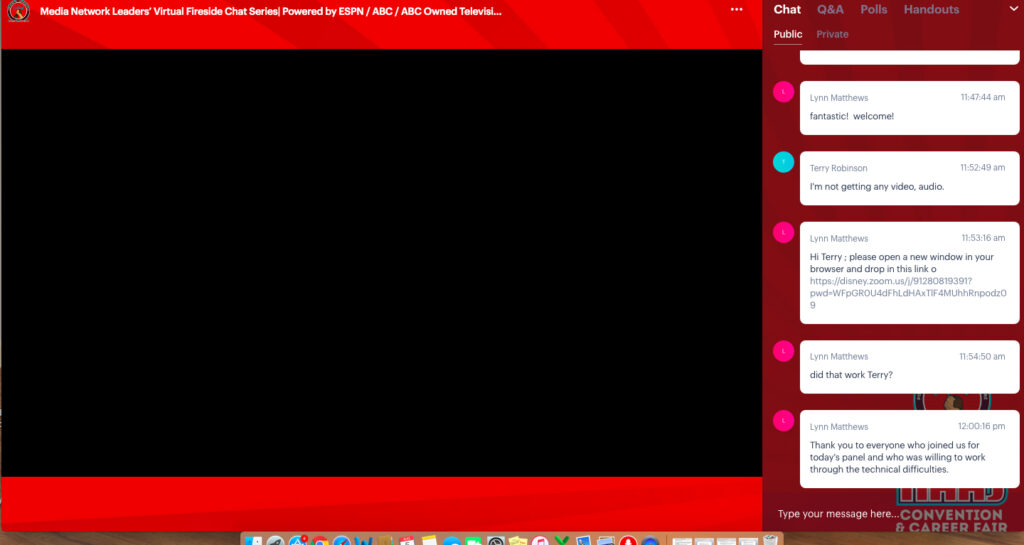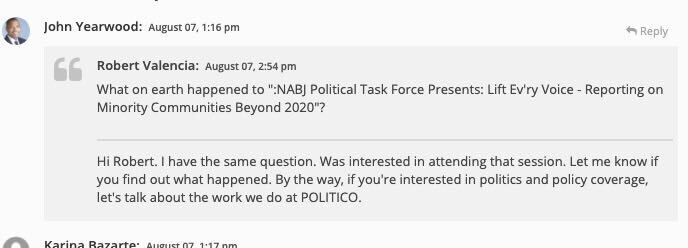Technical issues and confusion disrupt sessions, events at first-ever virtual NABJ-NAHJ joint 2020 conference

From trolls to Grubhub order cancellations, issues with pages refusing to load and not knowing where to find certain events or panels in the virtual landscape of a first-time online convention, the virtual 2020 NABJ NAHJ conference didn’t exactly go off without a hitch.
This is the first year the National Association of Black Journalists and the National Association of Hispanic Journalists convened for a joint annual conference digitally — spurred by the ongoing coronavirus pandemic.
In previous years, conference attendees would descend on a convention center in a predetermined city and find their way around using floor plans, maps and schedules written for only one timezone. But this year, on an all-virtual platform, attendees said technical difficulties caused them to miss appointments with recruiters and show up to an empty screen where they thought a session would be.
Members were understanding — the first time for anything is likely to encounter bugs, they said — but yearned for the more seamless interaction of an in-person event.
Daniel Guererro, a student member of NAHJ, was one of the many who missed a session because of time-zone confusion.
“I was like, ‘Oh yeah, I’m definitely gonna watch that one because I like the people speaking,'” Guererro said. “I forgot that it was all in Eastern time. So by the time I logged on? Over.”
Fortunately, NABJ and NAHJ recorded many sessions and made them available for conference-goers to watch until Saturday evening.
Despite missing that first session, Guerrero said, the conference was still worthwhile. It allowed him to meet recruiters and virtually introduce himself to working journalists.
Denise Clay, a journalist from Philadelphia, showed up to sessions on time but ended up staring at a black screen with no panelists present.
Some guest speakers had to send an additional link to the people signed up for their panel in order to redirect them to a different, working room.
Clay says that although the sessions were generally good, the digital platform itself was glitchy.

NABJ and NAHJ contracted with virtual events firm vFairs to host the digital conference, and panels were largely conducted using online platform BigMarker.
“When you’re trying to (squeeze) a great big thing into a really small space, there’s going to be some glitches,” Clay said.
Robert Valencia, a conference attendee, said technical glitches are understandable, which is why many sessions had backup Zoom links. He said it would have been helpful if the back-up information was made readily available.
Valencia came across several sessions in which he had to be redirected. Each time, he said, he had to ask repeatedly for clarification.
“It’s a learning process,” Valencia said.

As a substitute for traditional luncheons and plenaries held over breakfast, NABJ and NAHJ offered confernce-goers a comped Grubhub delivery during some virtual events, but many members said they were left without a meal because Grubhub repeatedly canceled orders.
A message on the Grubhub app told users that the application was having technical issues and instructed those ordering to try again later.
The snags didn’t stop there.
At least one reported Zoom-bombing interrupted an event being sponsored by music streaming service, Spotify. An uninvited guest bombarded participants with explicit pornography and obscene audio.
“The fact that only happened, like once or twice, you know, throughout the conference, says something about the level of security,” Clay said. “But the fact that it happened at all — that’s not a good thing.”
Diane López Olea is a graduate of San Diego State University. As a student, she was the president of her university’s NAHJ chapter, wrote for The Daily Aztec in Spanish and English and worked as an assistant producer intern at Univision San Diego. Reach her at dlopezolea [at] gmail [dot] com and on Twitter @dianelopezolea.
Pingback: NABJ, NAHJ: 'Virtual' Is Here to Stay - journal-isms.com